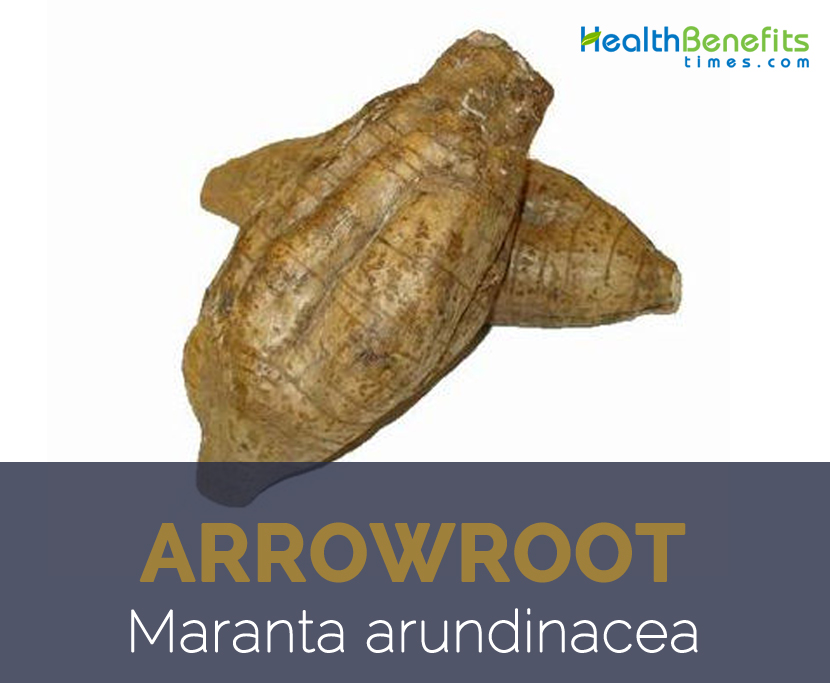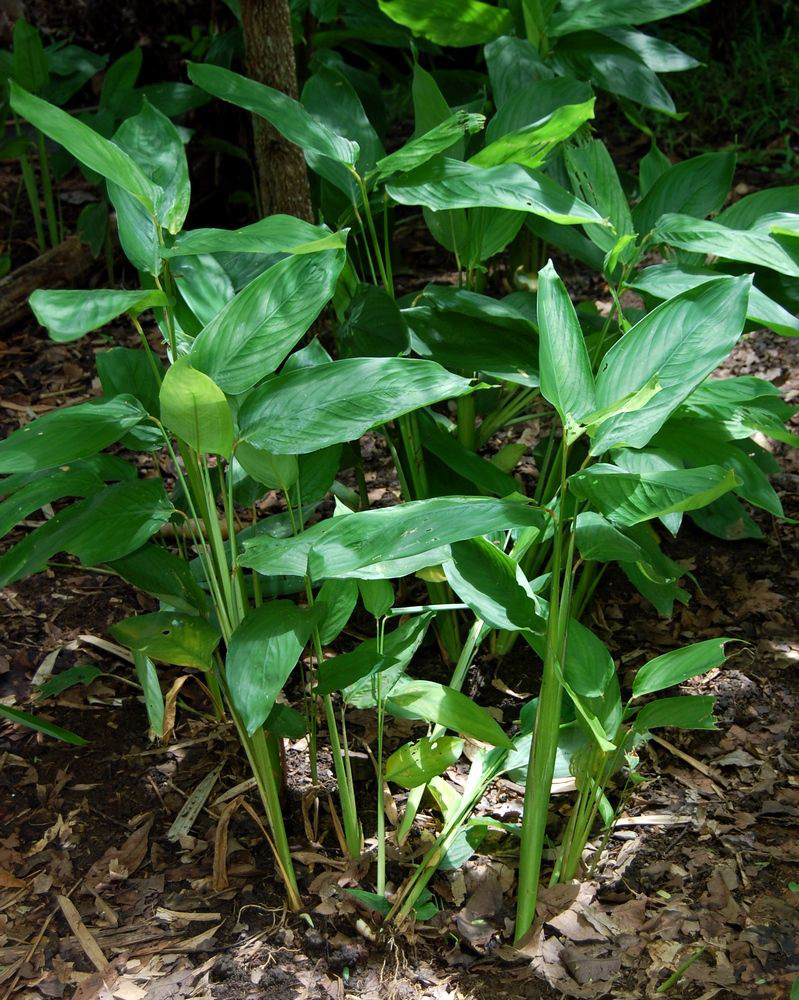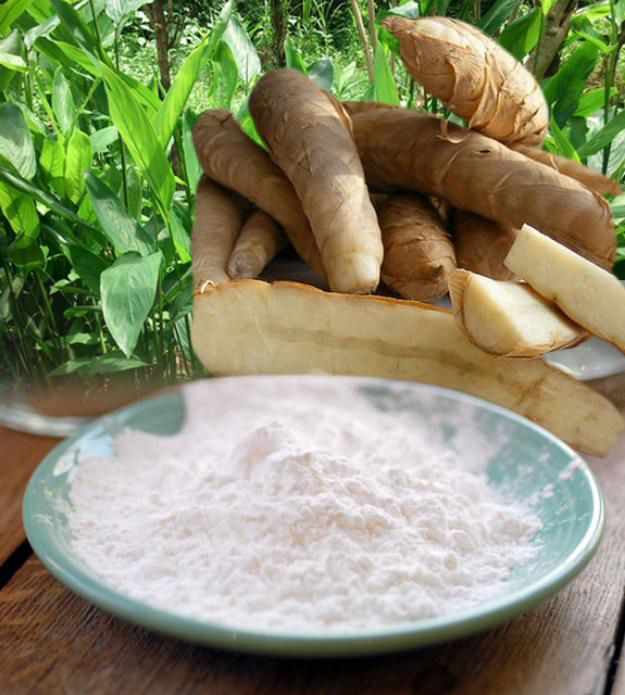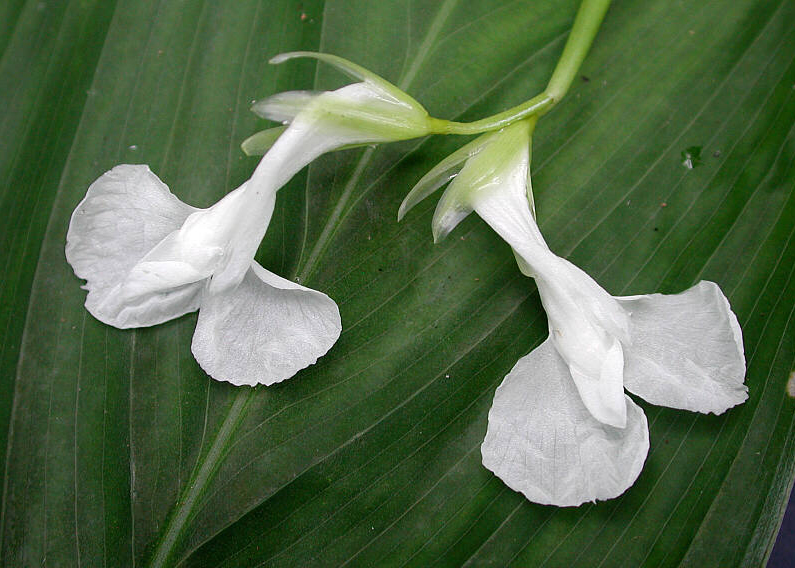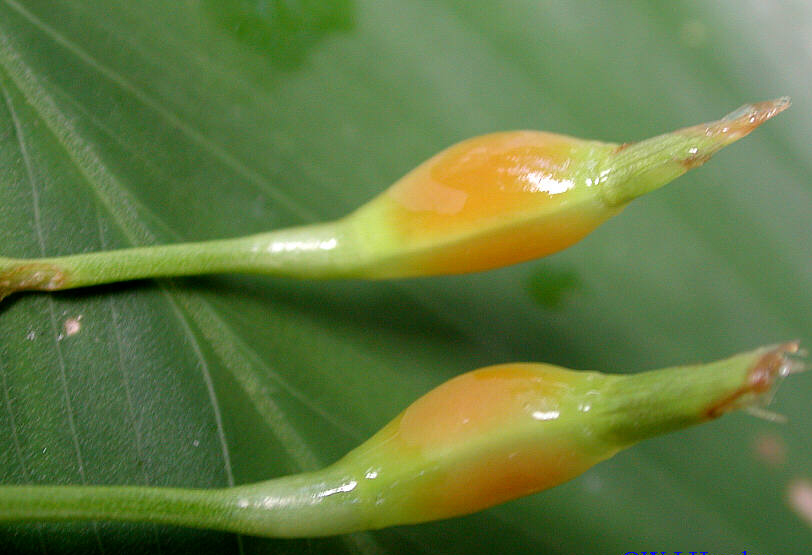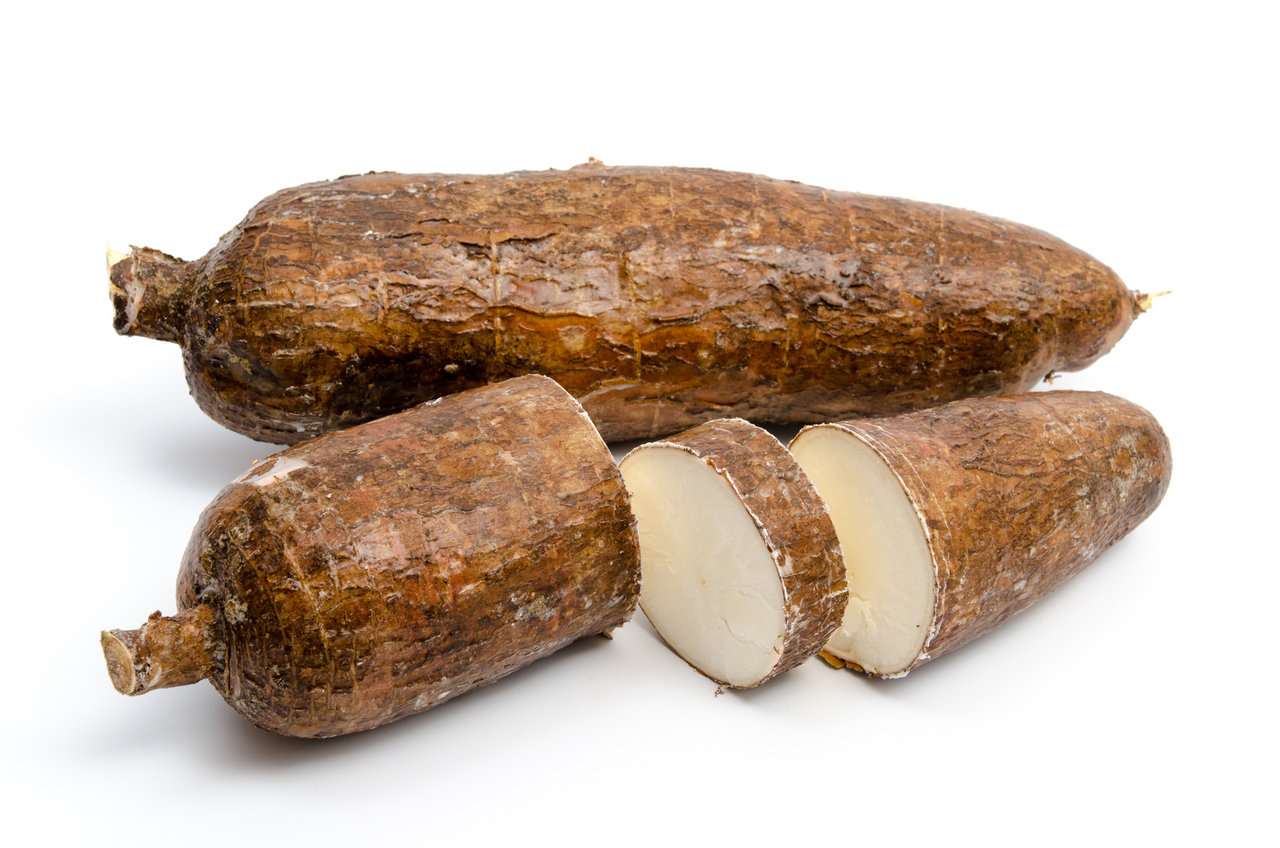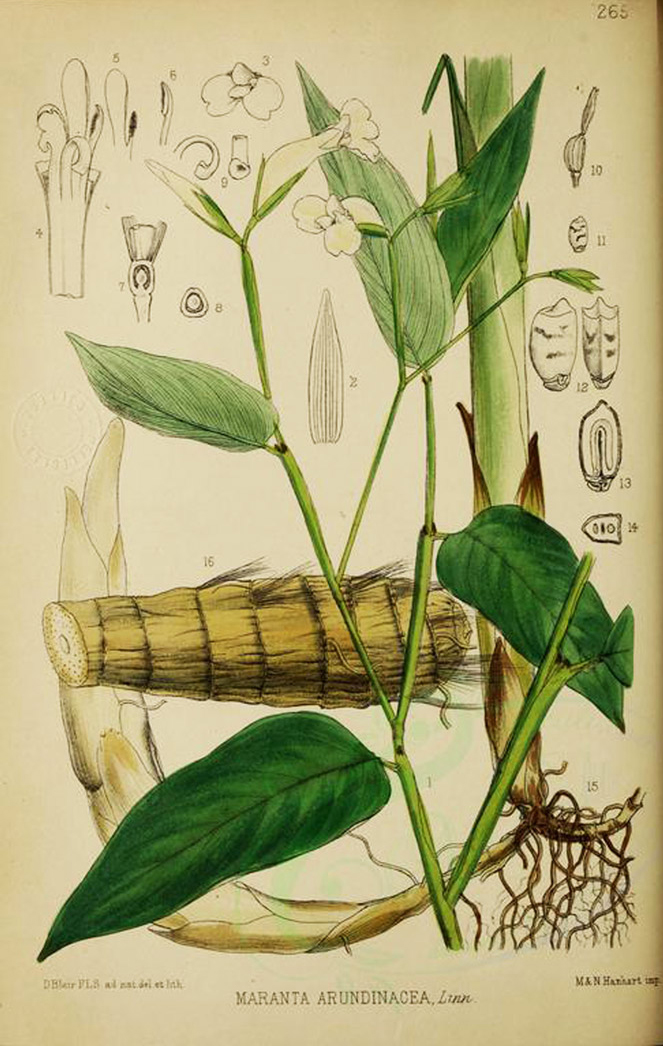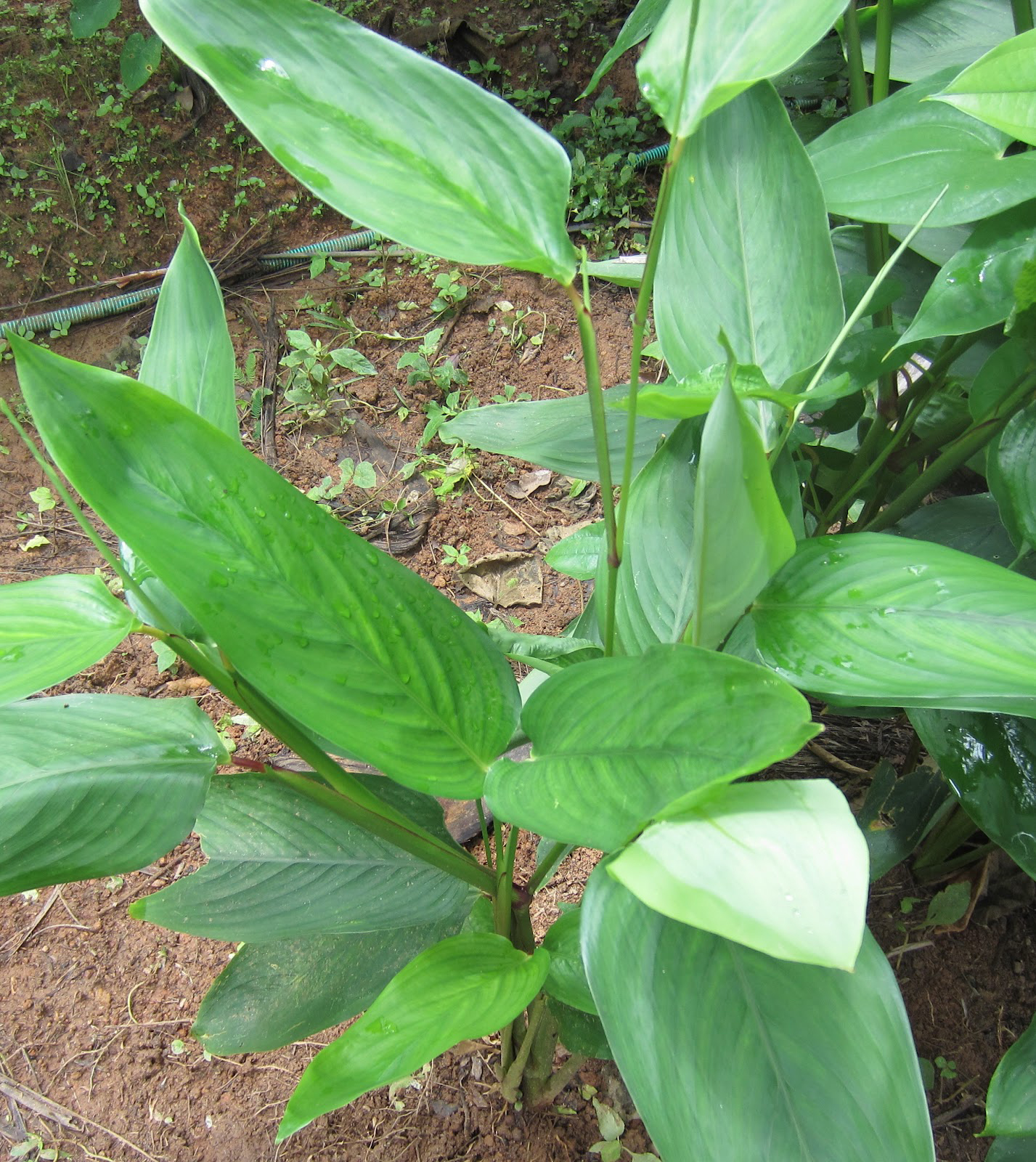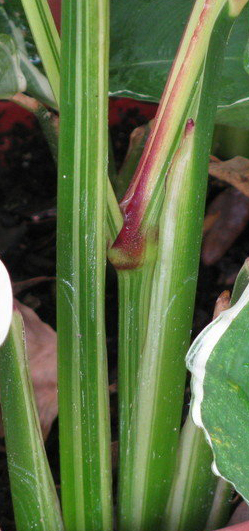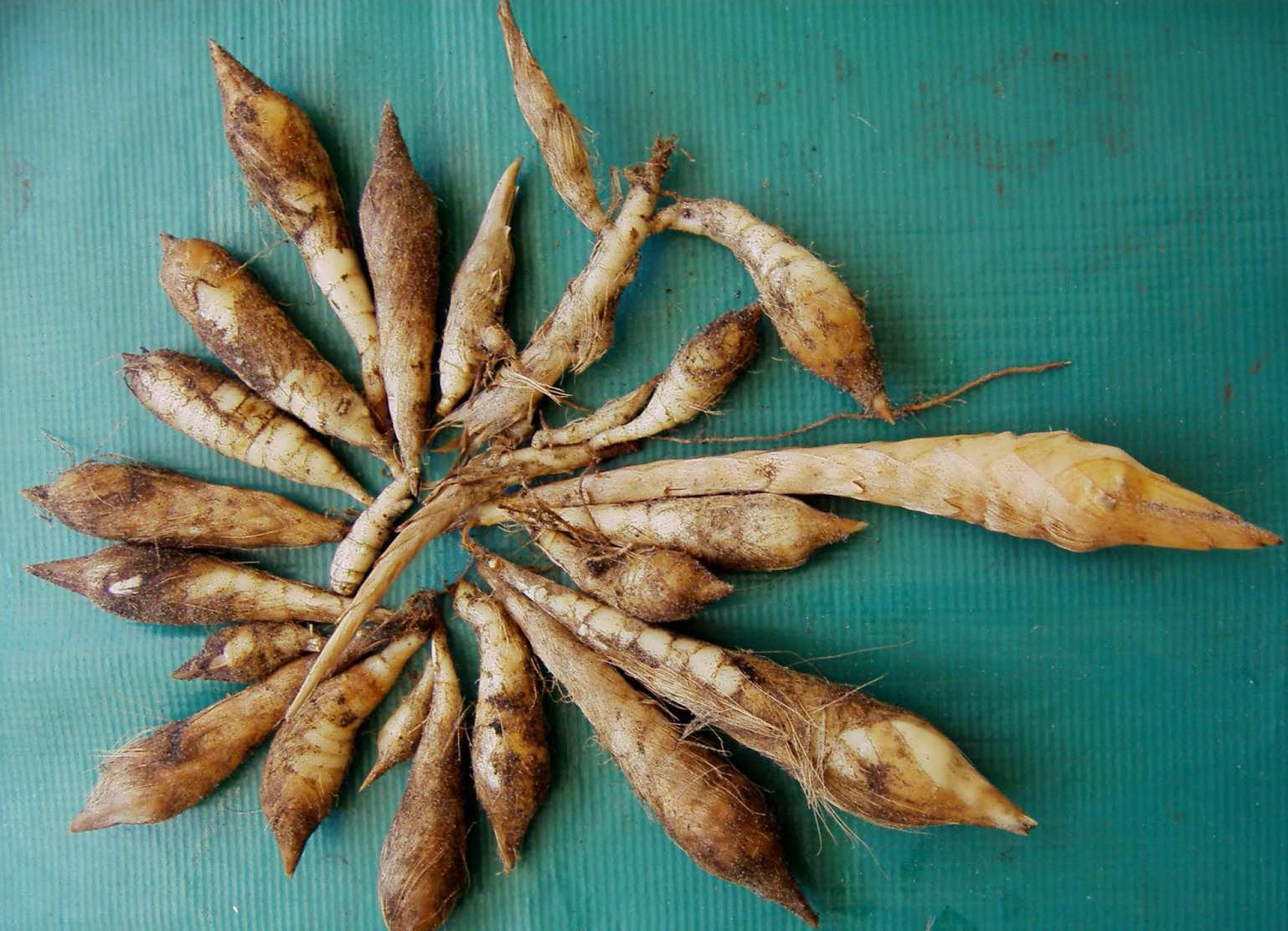| Arrowroot Quick Facts |
| Name: |
Arrowroot |
| Scientific Name: |
Maranta arundinacea |
| Origin |
Native to South America, the Caribbean and Mexico |
| Colors |
White, cream-white/light red |
| Shapes |
Sympodial, cylindric, fleshy, starchy and loosely scaly, about 25 cm long, and 13 cm in diameter (10 inches x 5 inches) |
| Taste |
White |
| Calories |
78 Kcal./cup |
| Major nutrients |
Vitamin B9 (101.50%)
Iron (33.25%)
Vitamin B6 (24.54%)
Phosphorus (16.86%)
Copper (16.11%) |
| Health benefits |
Aids Digestive System, Circulation Issues, Boosts Immune Function, Metabolic Processes, Heart Health, Safe for Infants, Birth Defects, Weight Loss Concerns, Treats Urinary Tract Infection, Stomach Concerns, Fights Foodborne Pathogens, Growth and Development |
| More facts about Arrowroot |
Arrowroot (Maranta arundinacea), is actually a starch rich, creeping underground rhizome that belongs to the Marantaceae family plants. The plant is native to the tropics of South America, where it has a long history of cultivation by native peoples and is widely grown in the Caribbean islands, Philippines and South America for its fine, easily digestible edible starch rich tubers. Arrowroot is cultivated primarily as a source of food starch which is found in cylindrical rhizomes. Some of the common names are Arrow Head, Arrow-root, Arrowroot, Bermuda Arrowroot, Maranta, Obedience Plant, St. Vincent Arrowroot and West Indian Arrowroot. It is widely considered an easily digested and nutritious starch. The herb is extracted from the fleshy roots, called rhizomes, of the arrowroot plant through an elaborate process of washing, peeling, soaking, and drying in the sun. Indians used arrowroot medicinally, they believed that is would draw out toxins in wounds made from poisoned arrows.
Plant
Arrowroot is a clumping perennial herb growing up to 30–130 cm high with erect slender stems often apically branched. It is found growing in warm, humid areas and normally prefers well-drained, alluvial and volcanic soils. Arrowroot is cultivated primarily as a source of food starch which is found in cylindrical rhizomes. Basal leaves are 4–8; cauline leaves 1–8; alternate, petiole 3.5–20 cm in basal leaves, often absent in cauline leaves; pulvinus 0.2–1.8 cm, glabrous, adaxially slightly tomentose; lamina ovate- oblong, 3.5–35 by 3–11 cm, pale-green, adaxially sparsely pilose, abaxially glabrous or sparsely pilose, base rounded to truncate, apex acuminate. Flowers on common pedicel; sepals green, narrowly ovate, corolla white, tubular, base inflated, lobes 8–10 mm; staminodes white, obovate, ovary three-loculed, densely pubescent, to sub-glabrous. Fruit is green or reddish-brown tinged, dehiscent, sub globose capsule, 7–8 mm by 4–5 mm and seeds are brown, rugose with basal aril.
Rhizome
Arrowroot is an easily digested starch extracted from the roots of the arrowroot plant and is cultivated as a source of food starch which is found in cylindrical rhizomes. It is not exactly a root but rather an underground mass of roots or root system. Rhizome are normally sympodial, cylindric, fleshy, starchy and loosely scaly, about 25 cm long, and 13 cm in diameter (10 inches x 5 inches) and is white, cream-white/light red in color. The weight is about 30 to 50 g per rhizome. Arrowroot has thin, light-brown skin and white colored flesh. They have a mild flavor and wonderful taste which is ideal for many food items, so it has been used in several food items since ancient times. Arrowroot is highly valued by herbal healthcare specialists mainly because of its demulcent as well as antidiarrheal qualities.
History
Maranta arundinacea commonly known as Arrowroot is native to South America, the Caribbean and Mexico. The plant has naturalized elsewhere in Florida, Australia, Southeast Asia and South and East Africa. It is mainly grown in the West Indies (especially Jamaica and St. Vincent). At present it is cultivated around the world due to its higher nutritional value and delightful taste.
Nutritional Value
Apart from their mild flavor and wonderful taste, arrowroot is a good source of nutrients, vitamins and minerals. Consuming 120 gram of arrowroots offers 406 µg of Vitamin B9, 2.66 mg of Iron, 0.319 mg of Vitamin B6, 118 mg of Phosphorus, 0.145 mg of Copper, 0.172 mg of Vitamin B1, 2.032 mg of Vitamin B3, 16.07 g of Carbohydrate, 545 mg of Potassium, 5.09 g of Protein and 0.209 mg of Manganese.
Health Benefits of Arrowroot
There are numerous health advantages of consuming Arrowroot. A number of the well-known health advantages are listed below-
1. Aids Digestive System
Arrowroot powder has been used as an aid for digestion for over a century, documented as early as 1900. In recent years, research has shown arrowroot to be an effective natural cure for diarrhea. Research determined the effectiveness of the powder to decrease diarrhea as well as constipation in patients with Irritable Bowel Syndrome (IBS) and discovered it to be exceptionally successful. Not only does it greatly reduce occurrences of diarrhea, but it also reduces abdominal pain.
Another study concentrated on the use of arrowroot for digestive health in areas of the world where severe diarrhea is common. Research on 3 groups of villages in south India discovered arrowroot water significantly decreased the incidence of diarrhea that was due to poor water and food quality.
While the particular reasons for decrease in digestive problems has yet to be determined, there is sufficient evidence, both historically and in recent years, that arrowroot is an excellent, all-natural, reasonable treatment for problems with digestion. To prevent constipation, it’s suggested that you don’t take arrowroot with other medications or supplements used to alleviate diarrhea.(1), (2)
2. Circulation Issues
Arrowroot consists of significant levels of copper and iron. These two crucial minerals are essential parts of red blood cells, which makes arrowroot very good for preventing anemia, which is considered by weakness, fatigue, and cognitive disorders. Besides, by increasing circulation, you encourage oxygenation of your body’s organ systems and extremities, which can boost your energy levels.(3)
3. Boosts Immune Function
The extracts of arrowroot powder display cytotoxic actions that help in building immunity. It means Maranta arundinacea extract increases the production of cells within the immune system.
An evaluation of the immunostimulatory effect of arrowroot in 2012 proved that those same tuber extracts encouraged the immune systems of cells, both when tested in vitro (in test tubes) and in vivo (in a live animal), again proving the usefulness of arrowroot in boosting immune system health.(4)
4. Metabolic Processes
High concentration of vitamin B within arrowroot makes it an important enzymatic and metabolic substance. The B-vitamin is very important in regulating processes throughout your body, from hormonal release to circadian rhythms, which means that you never want a deficiency in that department!(5)
5. Heart Health
Arrowroot consists of significant levels of potassium which mean it can be a definite line of defense against heart-related problems. Potassium is a vasodilator, meaning that it relaxes the tension in the blood vessels and arteries, thus lowering blood pressure and decreasing your risks of atherosclerosis, heart attacks, and strokes. Potassium is also known as a cognitive enhancer, encouraging the flow of oxygenated blood to the brain.(6)
6. Safe for Infants
Due to its starchy content as well as mild flavor, arrowroot is a safe ingredient to use in food for infants. You can use this starch in many several recipes for your infant or older children, without worrying about it causing tummy aches or other digestion issues.
Arrowroot is also a common ingredient in teething cookies for babies. As a virtually allergen-free product, it’s an ideal gum-soothing component that poses little to no risk of allergic reaction.
7. Birth Defects
One particular member of the B family of vitamins is folate, which is found abundantly in arrowroot. Researches have shown that folate is important for expecting mothers, since it can help to prevent neural tube defects in their unborn child. Folate is also an essential factor in DNA synthesis and healthy cell division, thus promoting rapid healing and healthy growth.(7)
8. Weight Loss Concerns
Arrowroot is low in calories as compared to other starches like potatoes, yams or cassava. Due to this, people trying to remain on a diet can get complex carbohydrates and a wealth of nutrients, as well as a healthy dose of dietary fiber, and disregard the desire to snack between meals. Arrowroot fills you up and gives you the minerals and vitamins your body needs.(8)
9. Treats Urinary Tract Infection
Women are more prone to urinary tract infections, or “UTI’s,” and are frequently recommended cleanliness and foods to help stave off future infection as well as calm inflammation. One such food is Arrowroot can be one of the effective home remedies for bladder infections or UTIs.
Arrowroot is a demulcent, which is simply a calming substance used to relieve pain in inflamed or irritated mucous membranes. As it earned its name by serving as a treatment for poisonous arrow wounds, it’s no surprise that this useful plant relieves inflammation.
The antiseptic features of arrowroot help treat UTI’s and also prevent some future flare-ups, so doctors often recommend common ingestion of it for women with frequent infections.
10. Stomach Concerns
Celiac disease seems to be the new global disease, and people are looking for gluten-free alternative to traditional starches and wheat. Arrowroot is one of the best gluten-free substances, making it very popular in recent years, as it can prevent the gastrointestinal discomfort, pain, and danger that those handling gluten intolerance must face every day.(9)
11. Fights Foodborne Pathogens
One interesting feature of arrowroot is its capability to fight foodborne pathogens that cause illness. Research has demonstrated a reduction in pathogens in various foods, particularly liquid foods such as soup. Here, arrowroot tea hugely reduced the amount of salmonella virus in the soups that were tested.
This is yet another reason why arrowroot is a suggested medicinal food ingredient to keep the digestive system safe. It also speaks to some far-reaching effects it might have to help protect people in third-world countries from some of the more common infections due to poor water quality.(10)
12. Growth and Development
When compared to other root vegetables and starches acquires from tubers, arrowroot has a higher concentration of protein, an important component of any diet. By increasing our dietary intake of plant proteins, which are easier to process than animal proteins, we can assure healthy growth and development.(11)
How to Eat
- Arrowroot rhizome and starch are used as food in the form of puddings, pastries, jellies, cakes, biscuits, cookies hot sauces and used with beef, tea, milk, meal, broth and noodles in Vietnamese and Korean cuisines.
- It offers easily digestible, nourishing food for kids and people with dietary restrictions and convalescents.
- It is well suited as weaning food for infants from breast milk.
- Arrowroot makes clear, shimmering fruit gels and avoids ice crystals from forming in homemade ice cream.
- It can also be used as a thickener for acidic foods, such as Asian sweet and sour sauce.
- The absence of gluten in arrowroot flour makes it useful as a replacement for wheat flour in baking.
Other traditional uses and benefits of Arrowroot
- Traditionally the tuberous rhizomes are used in the treatment of diarrhea.
- Arrowroot is mainly useful as an easily digested, nourishing diet for patients especially for bowel complaints as it has demulcent properties.
- Arrowroot starch in jelly form is appropriate as weaning food for infants.
- Smashed rhizomes are applied topically for injuries from poisoned arrows, scorpion and black spider bites and to arrest gangrene.
- Freshly expressed juice mixed with water is used as antidote internally for vegetable poisons.
- For relief of mouth and gum pain, you can apply the powder directly to the gums.
Other Facts
- Arrowroot was found to be a food, feed, fuel and fiber resource.
- Arrowroot can be used as screens between neighboring houses.
- It provides outstanding compost and mulch.
- Shoot tips and leaves can be utilized as feed for pigs, goats and chickens.
- Individual leaves are used as plates during picnics.
Selection and storage
Industrial arrowroot can be purchased in the form of its powder (flour) which is usually meant to use as stabilizer/thickener in food industries. Whenever included with boiled water it becomes thin, clear, odor free jelly. The root itself found no or even minimal use within cooking.
Fresh soft could be consumed raw as well as in cooking while you use as with any other tubers. However, mature roots are extremely fibrous and therefore, much less delicious. If you plan to purchase the arrowroot flour, search for branded product showing genuineness, quality, as well as pureness. Adulteration along with cheap substances just like cornstarch, potato powder, tapioca, etc., is a very common practice. Don’t buy loose/opened packs.
Once in your own home, keep pack within cool dry place faraway from dampness and direct sunlight. Usually do not refrigerate.
Preparation and serving methods
To make arrowroot powder, High-quality soft root base is chosen. Clean them completely within cold water. Scrape or even peel off the outer surface. Beat the tubers within mortar till they turn out to be single pulp as well as milk oozes out is sieved utilizing cheesecloth. The milk acquired thus is then dried beneath sunlight to get fine, white arrowroot powder. Generally speaking, arrowroot flour is included as thickener, colloidal stabilizer, holding agent in liquid-based recipes. It’s got several positive aspects over other starch flours. It combines effectively in low temperature cooking and provides uniform viscosity to recipes. It features a neutral taste, helps prevent dextrinization (breaking carbohydrates to dextrins), and could be included with acidic-based recipes. However, it won’t go along well along with dairy-based recipes since it turns them slimy. One tablespoonful of flour is sufficient for the thickening a single serving of liquid.
Here are some serving tips:
- Arrowroot flour can be used in confectionaries like a thickening agent to create cakes, gels, mousse; as well as in kitchens to make soups, sauce, dressings, gravy, etc.
- Use its flour to provide ideal shapes to biscuits, cookies, and also pastries whilst decreasing the quantity of cholesterol rich solid fats (trans-fats).
Arrowroot uses
You might have perhaps utilized or even consumed an item that contains arrowroot at some point without even recognizing it. Listed here are 7 standard as well as modern uses of the powder. Obviously, arrowroot is utilized in several other ways, too.
- Carbonless copy papers utilized arrowroot just before technology discovered methods to split wheat flour into particles sufficiently small.
- It can be utilized just as one odor-less component within baby powder
- Arrowroot is a well-liked and efficient thickener of sauces
- Home-made natural deodorant can be created utilizing arrowroot to soak up sweat
- It really is utilized in animal feed
- Arrowroot biscuits obviously utilize this like a main ingredient
- Utilized medicinally, specifically for digestive problems
Precautions
Arrowroot just isn’t considered to be dangerous whenever used in suggested dosages. However, it is very important keep in mind that the long-term effects of utilizing the herb (in any amount) haven’t been researched. Because of the insufficient scientific research, arrowroot needs to be combined with caution in kids, ladies who are pregnant or even breast-feeding, and individuals along with liver or even kidney disease. Individuals who experience vomiting or even severe/prolonged diarrhea might be vulnerable to dehydration. They ought to get plenty of fluids (six to eight glasses each day) so as to keep a appropriate fluid balance. A doctor needs to be contacted if the vomiting or diarrhea lasts more than 3 days or is associated with various other symptoms just like pain or fever.
References:
https://en.wikipedia.org/wiki/Arrowroot
http://www.encyclopedia.com/topic/arrowroot.aspx
http://www.cooksinfo.com/arrowroot
https://www.feesers.com/sites/default/files/spices/pdfs/Arrowroot.pdf
https://edis.ifas.ufl.edu/pdffiles/MV/MV00900.pdf
http://www.jstor.org/stable/4254646?seq=1#page_scan_tab_contents
http://www.mitahatoedf.com/library/crop-production/doc_download/1-arrow-root-farming
Comments
comments


